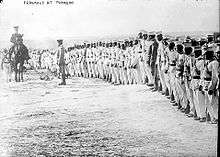Federal Army
The Mexican Federal Army (Spanish: Ejército Federal), also known as the Federales in popular culture, was the military of the Mexican state during the Porfiriato, the long rule of President Porfirio Díaz, and until 1914. Under President Díaz, a military hero against the French Intervention in Mexico, the Federal Army was composed of senior officers who had served in long ago conflicts. At the time of the outbreak of the Mexican Revolution most were old men and incapable of leading men on the battlefield.[1] When the rebellions broke out against Díaz following fraudulent elections of 1910, the Federal Army was incapable of responding.[2] Although revolutionary fighters helped bring Francisco I. Madero to power, Madero retained the Federal Army rather than the revolutionaries. Madero used the Federal Army to suppress rebellions against his government by Pascual Orozco and Emiliano Zapata. Madero placed General Victoriano Huerta as interim commander of the military during the Ten Tragic Days of February 1913 to defend his government. Huerta changed sides and ousted Madero's government. Rebellions broke out against Huerta's regime. When revolutionary armies succeeded in ousting Huerta in July 1914, the Federal Army ceased to exist as an entity.[3][4]
| A graphical timeline is available at Timeline of the Mexican Revolution |

Overview
In February 1912, the Federal army consisted of 32,594 regulars and 15,550 irregulars. This was far below the official number of 80,000 as stated by the army executive. By September of the same year the official strength of the army was 85,000 men. In addition there were 16,000 Rurales, 4,000 Urban Police and 16,200 Militia, rural guards and other pro-government men under arms. In April 1914 Huerta claimed his army had reached the size of 250,000 men, with 31 regiments of Rurales and 31,000 Militia. A more realistic assessment of his men by that July was 71,000, while U.S. observers said it was closer to 40,000.
Specific numbers aside, the rapid expansion of the army had led to a deterioration in the quality of the average recruit, or more accurately, conscript. Huerta made an attempt to increase the size of the army by ordering a mass levy, or forced conscription from the streets by his press-gangs, who would fall upon men as they left church or pull them from cinemas. Very few of the men under his command were volunteers and many deserted the army. Huerta tried improving morale by increasing pay in May 1913 by 50%. At the same time 382 military cadets were given commissions and attempts were made to increase the number in training.
Federal army generals were often corrupt and guilty of undermining morale with poor leadership. Some were so corrupt their dealings extended as far as selling ammunition, food and uniforms to the enemy. Also guilty of this corruption were Huerta's two sons, Victoriano Jr. and Jorge, both of whom had been placed in important positions overseeing the procurement of arms, supplies, uniforms and ammunition.
Despite these problems Huerta worked at creating an army capable of keeping him in power. He tried to expand the army by creating new units to distance them from the defeatism of the former Porfirista army. To bolster the resolve of the population he militarized society in the Prussian style, including military-style uniforms for all government employees and schoolboys and military drills on Sundays. Huerta and his general also sent 31 cadets to Europe to study military aviation in order to increase Mexico's air power.
Huerta's greatest success was attracting the support of many former rebels, such as Benjamin Argumedo, "Cheche" Campos and, most notably, Pascual Orozco, whom Huerta had fought against when serving Madero's government. Orozco offered Huerta the services of his 3,000–4,000 seasoned men, who proved essential in the fight against the Constitutionalist armies. When not helping the defense of Federal garrisons and towns, Orozco's men acted as very effective guerrillas.
The Federal Army was disbanded on August 13, 1914, a month after Huerta's exile. "Totally discredited, the old Federal army had come to the end of its run. Unable to control the Zapatistas, the Villistas, and other rebels, following the expulsion of Huerta, the Federist force disbanded and disappeared."[5]
At the time the full strength of the Federal army was 10 Generals of Division, 61 Generals of Brigade, 1,006 Jefes, 2,446 Officers, 24,800 other ranks and 7,058 horses. In addition there were 21 regiments of Rurales with 500 men in each, a total of 10,500 men.
The Federal army was replaced by the Constitutional Army of Venustiano Carranza under the terms of the Teoloyucan Treaties, although they too were known as Federales after Huertas's defeat.
References
- Knight, Alan. The Mexican Revolution Volume 1. p. 18. ISBN 0-8032-7770-9.
- Christon Archer, "Military, 1821-1914" in Encyclopedia of Mexico, vol. 2, p. 909. Chicago: Fitzroy Dearborn 1997.
- Archer, "Military," p. 910.
- Katz, Friedrich (1998). The Life and Times of Pancho Villa. Stanford University Press. p. 217. ISBN 0-8047-3046-6.
- Archer, "Military," p. 910.